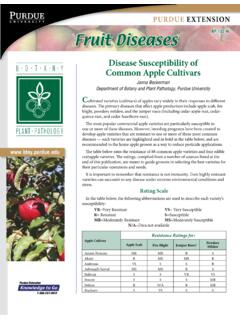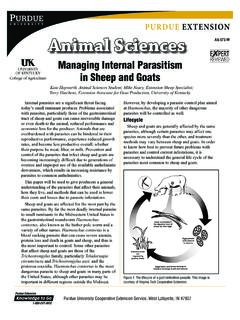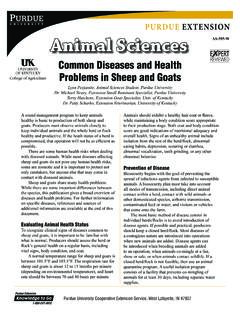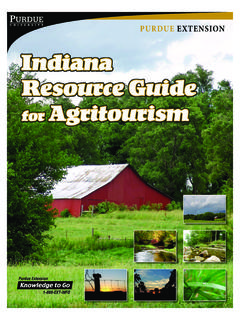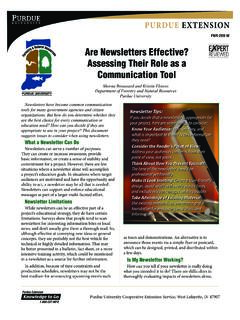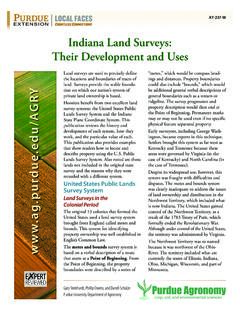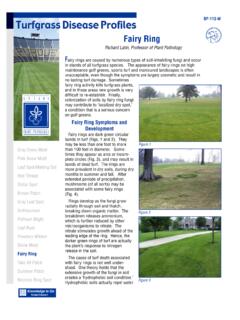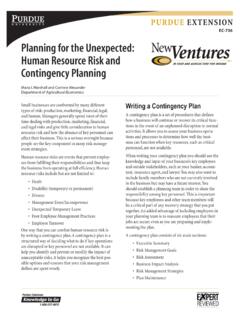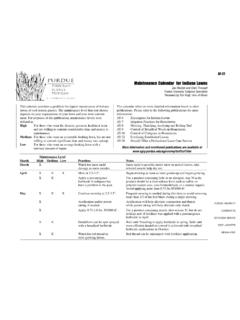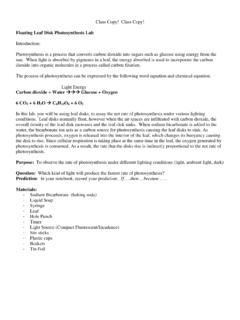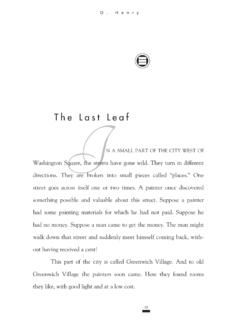Transcription of Northern Corn Leaf Blight - Purdue Extension
1 Northern corn leaf Blight Purdue Extension Purdue Extension BP-84-W. diseases of corn Northern corn leaf Blight Author: Kiersten Wise Northern corn leaf Blight (NCLB), caused 3. The impact of the disease by the fungus Exserohilum turcicum, is an 4. How to manage the disease increasingly important disease in the corn Belt. The disease has appeared Identifying the Disease annually in Indiana, and has increased in Early NCLB symptoms appear as long, prevalence since the mid- to late 2000s. narrow, tan lesions that form parallel to NCLB can cause yield loss if it develops leaf margins (Figure 1). As these lesions before or during the tasseling and silking develop, the classic symptoms of NCLB.
2 Phases of corn development. Hybrid will be observed: long, oblong, or cigar- susceptibility, cropping practices, and shaped tan or grayish lesions (Figure 2). w w w. bt rdu du weather strongly influence disease devel- The lesions produce olive-green or black opment. fungal spores when humidity is high, This publication describes: which can give the lesions a dark or dirty appearance. The spores are visible if one 1. How to correctly identify the disease examines lesions with a hand lens (Figure 2. Conditions that favor disease 3). The lesions range from 1 to 7 inches development long, depending on hybrid susceptibility. Multiple lesions may form on a leaf , and lesions can coalesce to form large, irregular areas of dead tissue on the leaves.
3 Disease symptoms vary by hybrid suscep- tibility. There are several genetic types (or races) of the Exserohilum turcicum fungus. Hybrids with partial resistance to NCLB. typically produce fewer and smaller Figure 1. Long, narrow lesions that run parallel to the leaf margin are early symptoms of NCLB. Photos by Kiersten Wise and Greg Shaner Figure 2. Oblong lesions develop on leaf tissue after infection Figure 3. Within NCLB lesions, fungal spores form, which can by the NCLB fungus, Exserohilum turcicum. be viewed with a hand lens. 1. Northern corn leaf Blight Purdue Extension lesions, and fewer fungal spores. On hybrids with are splashed or wind-blown to upper leaves or to other race-specific resistance, lesions are small and yellow and plants.
4 Due to the length of the infection process, symp- produce no spores (Figure 4). NCLB lesions may also toms may not be noticeable for one or two weeks after appear on the leaf sheaths and husks of susceptible infection occurs, depending on weather conditions and hybrids. hybrid susceptibility. Hot, dry weather restricts disease development and spread. Disease Impact NCLB can reduce yield when conditions are favorable for early development of the disease. Lesions reduce the leaf area of the plant that carries out photosynthesis. The more lesions on a plant and the earlier in the season the lesions develop, the greater the loss of photosynthet- ic area. If lesions have reached the ear leaf or higher during the two weeks before and after tasseling, yield loss could occur.
5 Hybrid corn yield could be reduced as much as 30 percent if lesions are present prior to or at tasseling. Yield losses in popcorn, sweet corn , or other specialty Figure 4. Hybrids with resistance to NCLB will have smaller lesions that may not corn production systems may be greater. produce fungal spores. If lesions do not appear on upper leaves until late in the NCLB symptoms may be confused with symptoms of season, yield losses will be less. Unfortunately, there is other foliar fungal diseases such as Diplodia leaf streak, not a clear relationship between the amount of leaf southern corn leaf Blight , and Stewart's or Goss's wilt tissue covered by lesions and the amount of yield loss, so an accurate diagnosis is important.
6 So it is not possible to say that a given severity of disease will result in a given loss of yield for any hybrid. Conditions Favoring In addition to the potential for yield loss caused by a Disease Development loss of photosynthetic area, NCLB lesions can contrib- The NCLB fungus survives through the winter on ute to stalk rot development and lodging. infected corn residue at the soil surface. As temperatures rise in the spring and early summer, the fungus produces Managing the Disease spores on residue, and then the spores are splashed or Preventative management strategies can reduce econom- wind-blown onto leaves of the new corn crop. ic losses from NCLB. No-till or reduced-till fields planted to susceptible hybrids are at high risk for NCLB.
7 Infection occurs during periods of moderate (64 to development, but weather will be the primary factor for 81 F), wet, and humid weather. The fungus requires six disease development. Preventative management is to 18 hours of water on the leaf surface to cause infec- especially important for fields at high risk for disease tion. Therefore, symptoms are commonly observed development. In-season disease management options, following long periods of heavy dew and overcast days, such as fungicides, are also available. and in bottomlands or fields adjacent to woods where humidity will be higher and dew will persist longer into the When developing an NCLB management plant, con- morning.
8 In Indiana, symptoms are frequently observed sider the following factors. late in the growing season, when days become cooler. Select Resistant Hybrids In years when summers are cooler and wetter than Choose a hybrid with moderate resistance to NCLB. normal, the disease can develop earlier. Under favorable Although sporulating lesions will develop on hybrids conditions, lesions can form seven to 12 days after with moderate resistance, the progress of disease is infection. Each lesion can produce many spores, which delayed sufficiently to protect against yield loss. 2. Northern corn leaf Blight Purdue Extension Hybrids will show different degrees of moderate factors), must be considered when deciding whether or resistance.
9 Some seed companies indicate the degree of not to apply a fungicide for NCLB management. resistance with a numerical rating scale, but pay close Currently, there are no thresholds specifically for NCLB. attention to these scales individual companies use management to aid in fungicide decisions; however, it is different values to indicate the level of resistance. In important to prevent yield loss by protecting the ear leaf areas where NCLB is a chronic problem, producers and the leaves above it as the plant enters the reproductive should seek out hybrids with race-specific resistance stages. genes (known as Ht genes). Scout fields around V14 (or just prior to tassel emergence).
10 Manage Residue to help determine the level of disease pressure in a field. Production practices that encourage residue to decom- When scouting and weather forecasts indicate that the pose will reduce the amount of fungus present to infect potential for disease development is high, fungicides the next corn crop. Continuous corn and no-till or that are applied at the tasseling to early silking stages reduced tillage systems are at high risk for disease (VT-R1) have the greatest likelihood of economic development due to the amount of residue left on the return. Before deciding to apply fungicides, consider soil surface. cropping practices, predicted weather conditions, and A one-year rotation away from corn , followed by tillage economic factors.
